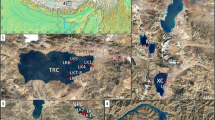Abstract
Climatic changes in the Plio-Pleistocene of East Africa during the evolutionary development of early man have been identified only in their broadest outlines. A variety of palaeontological1–3 and geochemical4 techniques have already been applied to the study of palaeoclimates in this area, but the use of stable oxygen isotope ratios, so helpful in marine palaeoclimatology, has not been fully exploited5,6. The frequent occurrence of well-preserved mollusc shells in the sedimentary column at Lake Turkana provides a sensitive oxygen isotope record, varying over a range of 7‰, which can be interpreted in terms of evaporative concentration of the heavier oxygen isotope in waters of the closed lake, alternating with isotopically lighter freshwater when the lake has been open. I report here the results of a study of the 18O/16O ratios of three species of gastropods from the sediments of the Koobi Fora region of Lake Turkana, and evaluate how the technique might be applied to the study of the palaeoclimates of other tropical lakes.
Similar content being viewed by others
References
Bonnefille, R. Bull. Soc, geol. Fr. 21, 331–342 (1979).
Harris, J. M. in Earliest Man and Environments in the Lake Turkana Basin (eds Coppens, Y. et al.) 293–301 (University of Chicago Press, 1976).
Williamson, P. G. Nature 293, 437–443 (1981).
Cerling, T. E., Hay, R. L. & O'Neil, J. R. Nature 267, 137–138 (1977).
Cerling, T. E. Palaeogeogr., Palaeoclimatol., Palaeoecol. 27, 247–285 (1979).
Abell, P. I., Awramik, S. M., Osborne, R. H. & Tomellini, S. Sed. Geol. (in the press).
Leakey, R. E. & Leakey, M. Koobi Fora Research Project Monogr. Vol. 1 (Clarendon, Oxford, 1979).
Isaac, G. L. in Earliest Man and Environments in the Lake Turkana Basin (eds Coppens, Y. et al.) 533–551 (University of Chicago Press, 1976).
Williamson, P. G. thesis, Univ. Bristol (1980).
Craig, H. Geochim. cosmochim. Acta 3, 53–92 (1953).
Williamson, P. G. Nature 295, 140–142 (1982).
Craig, H. Science 133, 1702–1703 (1961).
Lloyd, R. M. Geochim. cosmochim. Acta 30, 801–814 (1966).
Fontes, J.-C. & Gonfiantini, R. Earth planet. Sci. Lett. 3, 258–266 (1967).
Butzer, K. W., Isaac, G. L., Richardson, J. L. & Washbourn-Kamau, C. Science 175, 1069–1076 (1972).
Cerling, T. E. thesis, Univ. California, Berkeley (1977).
Craig, H. in Conf. Stable Isotopes in Oceanographic Studies and Paleotemperatures, 3–24 (1965).
Beadle, L. C. The Inland Waters of Tropical Africa (Longmans, London, 1974).
Cerling, T. E. & Brown, F. H. Nature (in the press).
Brown, F. H. & Cerling, T. E. Nature (in the press).
Author information
Authors and Affiliations
Rights and permissions
About this article
Cite this article
Abell, P. Palaeoclimates at Lake Turkana, Kenya, from oxygen isotope ratios of gastropod shells. Nature 297, 321–323 (1982). https://doi.org/10.1038/297321a0
Received:
Accepted:
Issue Date:
DOI: https://doi.org/10.1038/297321a0
- Springer Nature Limited
This article is cited by
-
Mammal diversity and environment evolution during the Plio-Pleistocene in East Africa
Human Evolution (1996)
-
Origin of carbonate materials in the northern Basin of Lake Baikal and its relationship to holocene paleoclimate
Chinese Journal of Oceanology and Limnology (1993)
-
Speciation in molluscs from Turkana Basin (reply)
Nature (1983)





